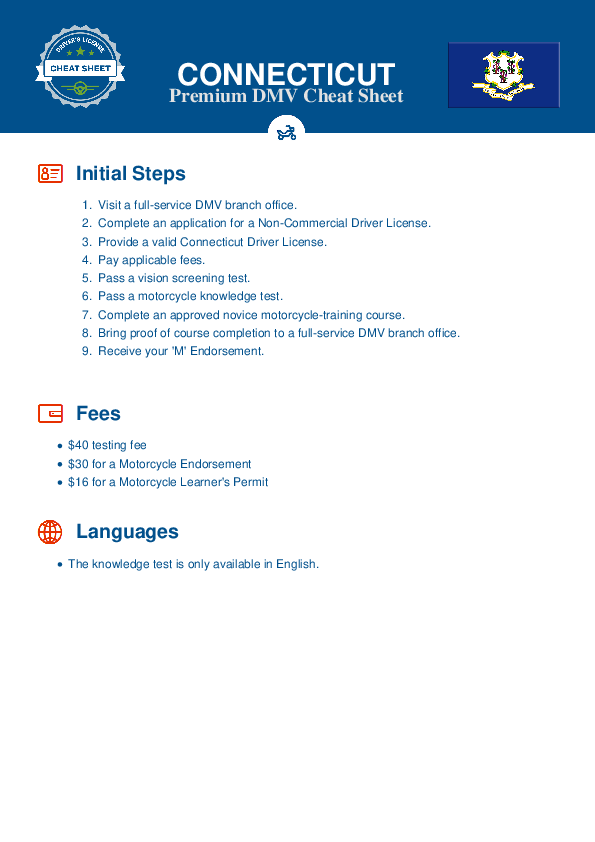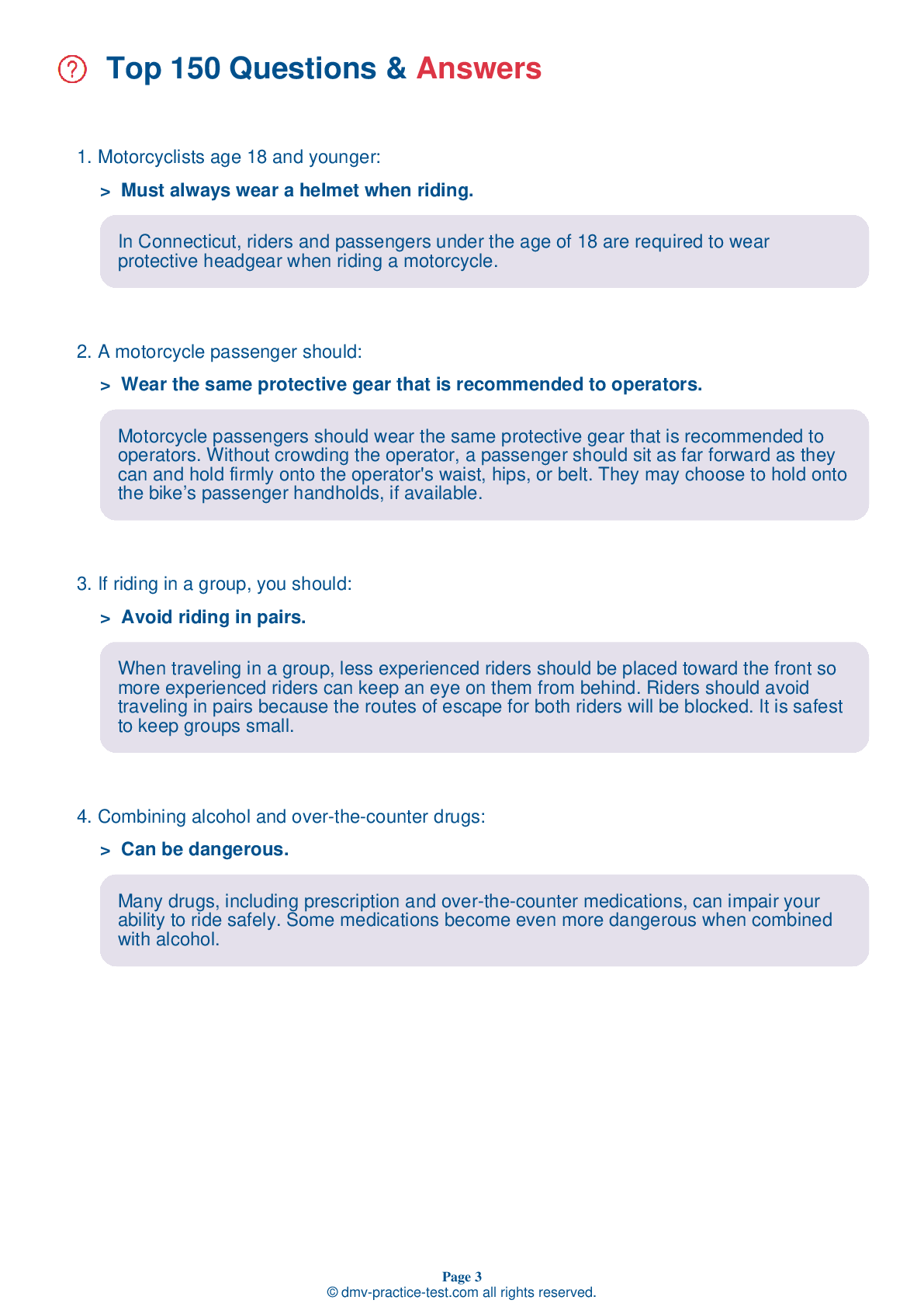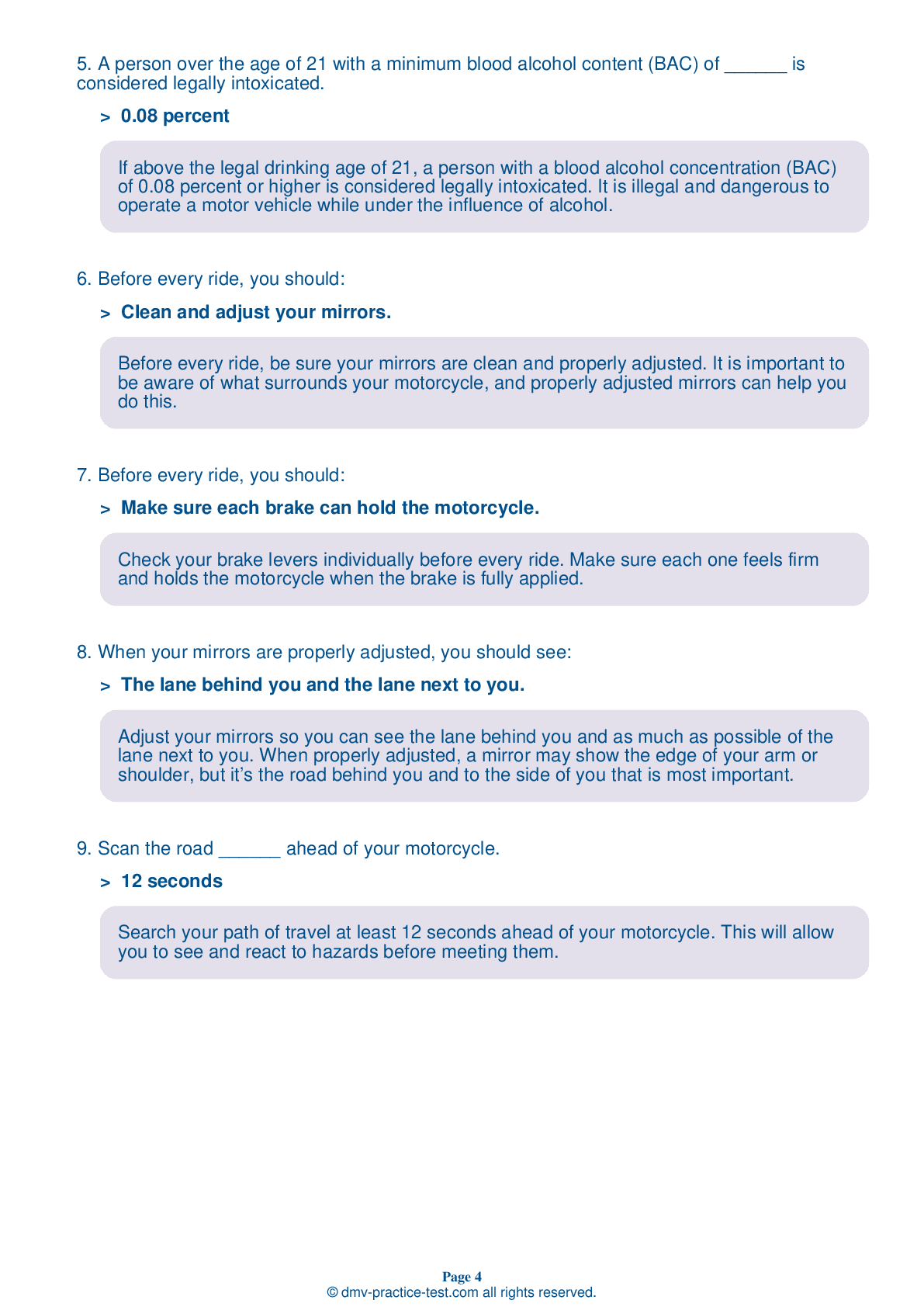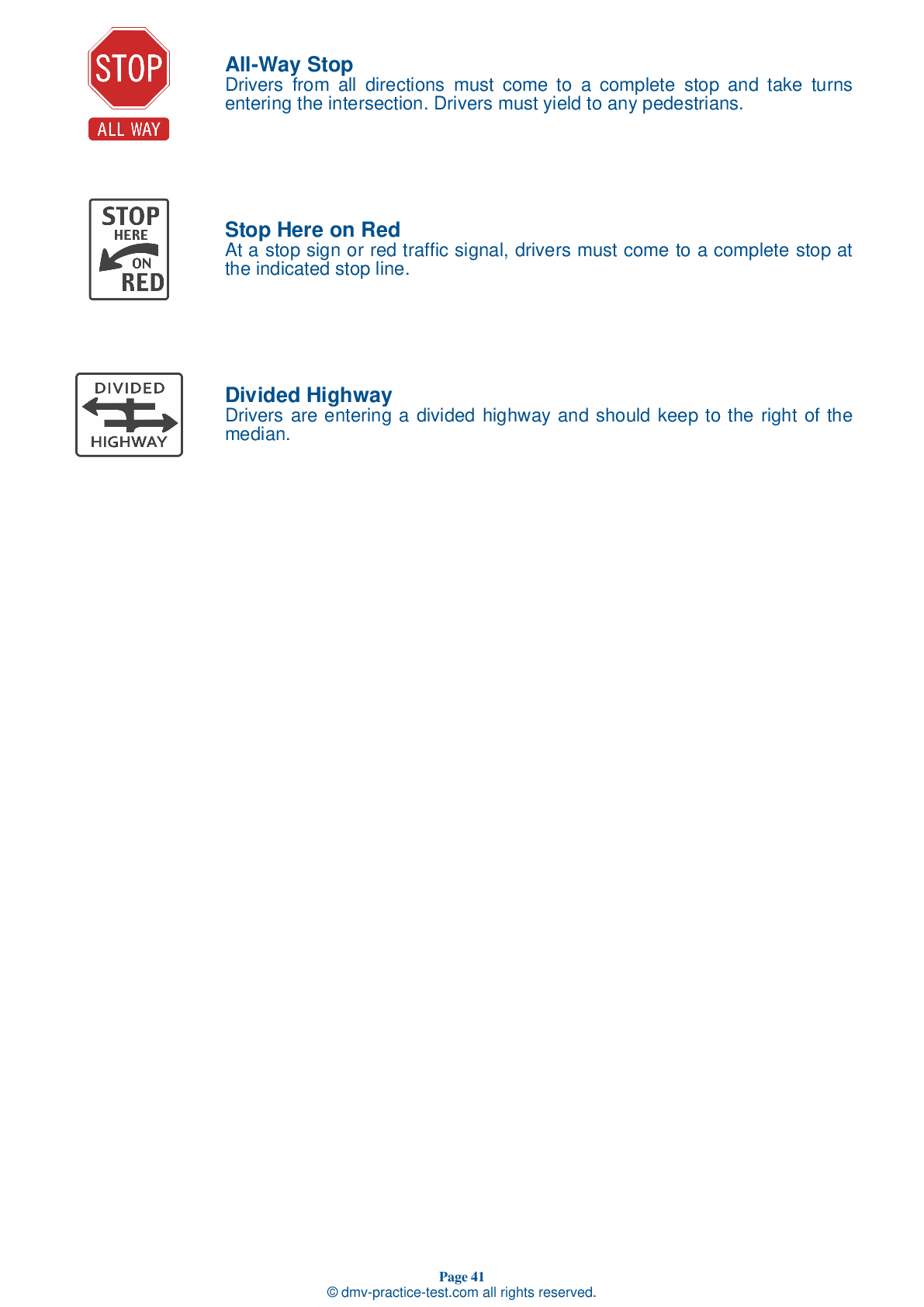DMV Permit Test #11
Motorcycle Test | License CT 2025 | FREE Online Practice! #11 Page 2 of 3
Take this FREE motorcycle test (license in CT 2025) to check your knowledge of the road rules. To improve your results, download a motorcycle handbook online, study theory, and practice for free on our website. Still worried about how to get a motorcycle license in Connecticut in 2025? Check our website for more sample tests, train as much as possible, and boost your grades!
16
12
16
6 . When riding, the best sitting position:
Keeps your knees away from the gas tank.
When riding, you should be seated in a posture that allows you to use your arms to steer rather than to hold yourself up. You should not have to stretch to reach the handgrips and your arms should be slightly bent when holding them. You should keep your knees against the gas tank to maintain your balance.
7 . Mirror checks should be done:
Infrequently, because they take your eyes off the road ahead.
Frequent mirror checks should be part of your normal scanning routine. Additionally, make a special point of using your mirrors before changing lanes, when stopping at an intersection, and before slowing down.
8 . Motorcycle riders should:
Only use a turn signal when turning left.
Road users should always signal their intentions before changing lanes, turning, or merging into traffic. Communicating with other drivers is an important part of preventing collisions.
9 . If your motorcycle begins to weave while you are riding over rain grooves or bridge gratings, you should:
Ride on the shoulder instead of on the grooves.
The weaving motion that occurs when a motorcycle rides over rain grooves or bridge gratings is generally not dangerous. If you experience weaving when riding over one of these surfaces, simply relax and proceed straight across the grooves or gratings at a steady speed. Trying to compensate for the weaving motion by zigzagging is more dangerous than riding straight.
10 . When riding a three-wheeled motorcycle, a rider should:
Ride on one wheel whenever possible.
When operating a three-wheeled motorcycle, it is possible to have only two wheels in contact with the ground. This condition occurs whenever enough weight is transferred outside of what are known as “tip-over lines.”
2025 Connecticut | Frequently Asked Questions
In Connecticut, to acquire a motorcycle driver's license, you must first obtain a motorcycle learner's permit by passing a knowledge test. After practicing with the permit, you can take the on-cycle skills test. Upon passing, you'll receive a motorcycle endorsement on your driver's license. Remember, you must also be at least 16 years old and have parental consent if under 18.
In Connecticut, the minimum age for obtaining a motorcycle driver's license is 16 years old. However, if you're under 18, you must obtain parental consent and complete both the Connecticut-approved novice motorcycle safety course and a standard driver's education course before applying for the license.
Yes, you do need a dedicated license for motorcycle riding in Connecticut. You can either obtain a motorcycle endorsement on your existing driver's license or a separate motorcycle-only license if you do not have a regular driver's license. Both require passing a knowledge test and an on-cycle skills test, or completing an approved safety course.
For a motorcycle license in Connecticut, you need a valid Connecticut driver's license, proof of identity, Social Security number, and Connecticut residency. If you've completed a Motorcycle Safety Foundation course, bring your completion certificate. If you're under 18, you also need a parental consent form. Fees for written and on-cycle tests apply, unless waived through course completion.
Yes, if you're applying for a motorcycle license in Connecticut without taking an approved training course, you need to take a written exam. It covers topics like motorcycle operation, traffic laws related to motorcycles, safe riding techniques, and handling emergency situations. The test is designed to evaluate your knowledge and understanding of operating a motorcycle safely.
The Connecticut motorcycle written test covers a variety of topics related to motorcycle safety and operation. These include rules of the road, motorcycle laws, handling dangerous surfaces, carrying passengers and cargo, group riding, avoiding collisions, and handling emergencies. The test is designed to assess your knowledge and understanding of safe motorcycle riding practices.
Yes, in Connecticut, if you complete a Motorcycle Safety Foundation (MSF) Basic Rider Course, you can waive the written and on-cycle driving tests required for a motorcycle endorsement. You must provide the DMV with the course completion certificate. However, you still need to pass the vision test and pay the appropriate fees.
To enroll in a motorcycle training course in Connecticut, you first need to choose a DMV-approved provider. Then, visit their website or call them directly to register for the course. You'll need to provide your personal information and pay any associated fees. The courses usually include classroom instruction and hands-on training. Some providers may require you to have a motorcycle learner's permit before enrolling.
No, you don't necessarily need to own a motorcycle for the license test in Connecticut. You can use any legally registered and insured motorcycle that passes a safety inspection. However, if you're a learner's permit holder, remember that you cannot ride on limited-access highways to get to the test site.
Yes, you can use a friend's motorcycle for the Connecticut driver's license evaluation. However, the motorcycle must be legally registered, insured, and pass a safety inspection. Moreover, you must have a way to legally transport the motorcycle to the test location, as learner's permit holders cannot ride on limited-access highways.
Yes, during the Connecticut motorcycle driving exam, you'll be tested on specific handling skills. These skills include starting and stopping, turning and swerving, quick stops, and obstacle avoidance. The exam also tests your ability to balance at low speeds, accelerate smoothly, and shift gears properly. It's crucial to demonstrate control and safety throughout the test.
Yes, new motorcycle drivers in Connecticut must first obtain a motorcycle learner's permit, which has several restrictions. These include no passengers, no riding on limited-access highways, and no riding after dark. After practicing with a permit, riders can then take a skills test to receive a motorcycle endorsement on their driver's license.
Yes, your Connecticut motorcycle license or endorsement is valid throughout the United States. It allows you to operate a motorcycle in all states under the Full Faith and Credit Clause of the U.S. Constitution. However, you must follow the specific motorcycle laws of the state you are in, as they can vary from Connecticut's laws.
In Connecticut, only motorcycle operators and passengers under 18 are required by law to wear a helmet. However, it's strongly recommended that all riders wear helmets for their safety, regardless of age. Helmets can greatly reduce the risk of serious injury or death in the event of an accident.
Yes, Connecticut offers two types of motorcycle licenses: a full motorcycle endorsement (M endorsement) and a motorcycle learner's permit. The M endorsement allows you to drive motorcycles without restrictions, while the learner's permit allows you to practice driving under certain restrictions. The type of license you need depends on your age and driving experience.
Yes, you can add supplementary endorsements to your motorcycle license in Connecticut. These might include endorsements for different classes of motorcycles or specific types of vehicles like three-wheeled motorcycles. However, each endorsement may require additional testing or training. It's best to check with the Connecticut Department of Motor Vehicles for specific requirements.
Yes, it is possible to take the motorcycle license test in different languages in Connecticut. The Connecticut Department of Motor Vehicles offers the test in several languages including Spanish, Polish, Portuguese, Italian, French, and others. It's recommended to check with your local DMV office for specific language availability.
An effective strategy to prepare for the motorcycle license test in Connecticut includes studying the Connecticut Motorcycle Operator's Manual thoroughly, taking practice tests to familiarize yourself with the format and types of questions, and understanding all road signs and rules. Practical training, if possible, can also help you better understand the riding techniques and safety measures.
Yes, the motorcycle written exam in Connecticut can be taken in languages other than English. The Connecticut Department of Motor Vehicles offers the written test in several languages, including Spanish, Polish, Portuguese, Italian, French, and more. However, it's advisable to check with your local DMV for the availability of specific languages.
If you do not pass the motorcycle written test in Connecticut, you are allowed to retake it. However, there is a mandatory 7-day waiting period before you can retake the test. It is advisable to use this time to study and better prepare for your next attempt. There may also be additional fees for retesting.



